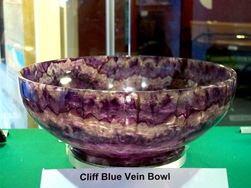Geologist and science writer Nina Morgan goes underground to discover a treasure trove.
 Picture: Bowl made from Derbyshire Blue John, on display in Castleton Visitor Centre. Source: Wikimedia commons.
Picture: Bowl made from Derbyshire Blue John, on display in Castleton Visitor Centre. Source: Wikimedia commons.
Vases and ornaments made from the fluorspar variety Blue John were must-have ornaments for the wealthy in the second half of the 18th Century. Although similar fluorspars are found elsewhere, the 'authentic' Blue John is found only in veins in the caverns and mines of Treak Cliff, near the Peak District town of Castleton in Derbyshire. The first known references to Blue John date from around 1700, but serious mining began around 1750, and the popularity of Blue John ornaments took off.
Fans included George III and Queen Charlotte who owned a set that included a clock, censers and candelabra in Blue John made in 1770 by the manufacturer, entrepreneur and Lunar Society member, Matthew Boulton. The stone was also used widely used as decorative panels in fireplace surrounds in large houses. Large bespoke items, such as the Chatsworth Tazza (a vase made from a single piece of Blue John in around 1842 for the Duke of Devonshire and now on display at Chatsworth) were popular among the wealthy. Meanwhile a trade in smaller Blue John items and jewellery for the masses flourished in 'petrification' shops in Derbyshire.
Magical mystery tour
In the 19th Century the Blue John caverns – formed within a reef limestone mass of early Carboniferous age – became a popular tourist destination. Visitors were guided by candlelight through the show caves which contained 'rooms' with exotic names such as the Variegated Cavern and the Crystallised Cavern to marvel at displays of flowstone, stalagmites, stalactites and 'organ pipes' which formed where stalactites and stalagmites meet.
In his book 1815 book Introduction to Geology, a book that inspired Charles Lyell [1797 – 1875] to take an interest in geology, the geologist Robert Bakewell [1767–1843], waxed lyrical about the caverns, writing that:
"were the descriptions of the grotto of Antiparos translated into the simple language of truth, I am inclined to believe it would be found inferior in magnificence and splendour of mineral decoration to the natural caverns in the Fluor Mine."
Under the carpet
Although commercial mining of Blue John ended around 1926, small quantities of Blue John are still excavated from parts of Treak Cliff. The Treak Cliff show caves, reopened in 1935 by the then leaseholder, John Royse, remain a popular tourist destination.
When Royse retired in 1945 and handed over the management of the caverns to the current leaseholders, Peter Harrison and his family, he left behind a legend and a mystery. During the handover, Royse revealed that he had discovered a significant new source of Blue John at Treak Cliff, but he died before he could describe its location.
This vein was only re-discovered by chance in January 2013 by the cavern manager, Gary Ridley and Harrison's grandson, John Turner, hidden under a piece of carpet and a layer of clay. The location, Harrison said, was one that “we've walked over for years and years". At current rates of extraction, the find is expected to last for at least a decade. And there is more to come. In 2015, Ridley discovered a further new vein just off the tourist route while trying out a new method of mining using a stone chainsaw.
In the 1870s when supplies were relatively plentiful, Blue John sold for £40/ton 'in the rough'. This translates into £3500 - £3700 in today's money. At that price, the Blue John mines at Treak Cliff may well be turning into gold mines. But fashions in ornamental stones change quickly, so shareholders are advised not to book that luxury holiday just yet!
Acknowledgements
Sources for this vignette include: the entry for Robert Bakewell by Hugh Torrens in the Oxford Dictionary of National Biography; the Wikipedia Entry for Treak Cliff; Trevor Ford, Blue John Fluorspar, Geology Today, vol 10 (5), 1994, pp. 186-190; James Croston, On Foot Through the Peak, third edition, 1876, and the website: www.bluejohnstone.com
* Nina Morgan is a geologist and science writer based near Oxford. Her latest book, The Geology of Oxford Gravestones, is available via www.gravestonegeology.uk